|
|
|
 |
Complete List of Sailing Vessels
To help those of you who may share my
passion of ships & sails but may not have
done much sailing of your own, I have
compiled the list below to help you to
understand the differences between different
types of sailing vessels. If you know
of a type of sailing vessel I have missed,
please take a moment to
Email Me
and let me know...
|

Vessel Type |
Definition and History |
Argosy
 |
These ships were large trading vessels
commonly built in the Ragusea regions of Dalmatia and Venice during the late
17th century. The actual word "Argosy" is derived from a corruption of the word
"Ragusea", likely originated from foreign sailors mispronouncing the word.
The Argosy had a substantial cargo capacity, slightly larger than that of
typical Spanish Nao, and were capable of being sailed with a very small crew. As
a result, these lumbering crafts were highly economical and very popular with
merchants trafficking their cargoes along the European coasts. Due in large part
to their bulky dimensions and poor navigational controls, the lumbering vessels
were very difficult to control in foul weather. As a result, their use was
typically limited to traveling the coastlines of Europe and almost never
transoceanic.
Sadly, no existing examples of these ships have ever been excavated or otherwise
recovered. We have many examples of these ships from literature and artworks,
but their exact dimensions and designs are due more to interpolations of ancient
documents than they are due to direct study. |
Balener
 |
A very common type of whaling vessel, the Balener was also known by a
variety of names such as: Baleinier, Ballenero, Baleinier, Baleniera.The
ship is very similar to a brig, generally with two masts equipped with square
rigged sails. Although there was a bit of variation depending on the individual
vessels, this class of ship was typically in the 150 to 200 ton range.
In later years, when whaling became less popular, many of these ships took
measure to deter governmental or private interference in their trade. It is
difficult to see in the image on the left, but the ship actually has fake cannon
holes painted on it's hull to give the appearance that it was an armed vessel. |
Ballinger
 |
The Ballinger class of vessels were 120 ton
clinker-built two masted ships.
A contemporary of the cog, by the late 1400s they were used as scouting and
raiding ships attached to the fleet |
Barge
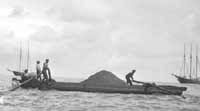 |
There are a great many variations of this
design throughout history, but nearly all of them adhere to the basic definition
below:Flat bottomed,
low draft inland cargo vessel for canals and rivers with or without it's own
propulsion. Barges are generally used for the transporting large amounts of
cargo, commonly stacked or heaped on it's main deck. This class of vessels
are referred to as a
"Lighter". |
Barque
 |
Vessel with
three or more masts with square sails on the fore mast and fore and aft sails on
the after mast. Generally in the range of 250 - 700 ton capacity.
A
well-preserved example of a commercial Barque is the Falls of Clyde. Built in
1878, it is now preserved as a museum ship in Honolulu, Hawaii.Additionally,
the United
States Coast Guard still has an operational Barque, built in Germany in 1936 and
captured as a war prize, named the USCGC Eagle.One of the oldest active sailing vessels
in the world, the Star of India, was built in 1863 as a fully square rigged ship
then was later converted into a Barque in 1901. |
Barquentine
 |
A vessel
with three or more masts with square sails on the foremast, and fore and aft
sails on the main and after masts. This class of vessel is typically rated in the 250
to 500 ton range. |
Battleship
 |
A large, heavily-armored and heavily-gunned
warship, which generally post-dates sailing vessels.This term is only listed
here to clarify the point to anyone new to this field that while there were
certainly a large number of sail-powered vessels used in sea combat, there were
never any sail powered "Battleships". |
Bergantina
 |
Medium sized sailing vessel common to the
early 19th century. Typically equipped with twenty-five guns, five
officers, a doctor, chaplain, and purser, and up to 150 Able bodied seamen. |
Bermuda rig
 |
The term Bermuda Rig refers to a configuration
of the mast and rigging for a type of sailboat, and is also known as a Marconi
rig; this is the typical configuration for most modern sailboats.
The rig consists of a triangular sail set aft of the mast, with its head raised to the
top of the mast, its luff running down the mast and normally attached to it for
all its length, its tack attached at the base of the mast, its foot controlled
by a boom, and its clew attached to the aft end of the boom, which is controlled
by its sheet. Originally developed for the Bermuda sloop, the Bermuda sail is either set as a
mainsail on the main mast, or as the course (the principal sail) on another
mast. The Bermuda rigging has largely replaced the older gaff rigged
fore-and-aft sails, except notably on schooners.
A Bermuda rigged sloop with
exactly one jib is known as a Bermuda sloop, Marconi sloop or Marconi rig.
Bermuda sloop can also refer to a more specific type of vessel. |
Bilander
 |
Also spelled
billander or be'landre, this two masted type of vessel was a realtively small merchant ship,
originally introduced by the Dutch. Although not uncommon for this vessel
to have ventured as far as the North Sea or the Mediterranean it was mostly
utilized for regional coastal trading or on the canals of Holland.The mainmast was lateen rigged but the foremast carried the
conventional square course and square topsail. They rarely reached a size of
more than 100 tons. |
Bireme
 |
The Bireme was a wooden hulled vessel used by
the Greeks for use in both both commercial shipping and in naval warfare, from
as early as approximately 350 BC.Configured with a single square rigged sail
on a short mast position amidships, the craft was also rigged with two tiers of
oars for rowers to provide "human-powered" propulsion should the vessel
encounter calm winds or for better control during combat.One of the many noteworthy elements of
this class of vessel was the bronze armored ram positioned on the bow of the
ship. This was designed to be driven into an enemy ship with maximum force in
order to cause a breach in the other ship's hull below the waterline and sinking
it.
Although a very small number of men were required to crew the ship when
relying on the sail, the ship could be equipped with as many as 45 sailors
during times of combat, as well as additional archers or soldiers on the main
deck for boarding enemy vessels once they have been rammed. The top speed of
this type of ship was around 7 knots. |
Blockade runner
 |
A ship
whose current business is to slip past a blockade. |
Boat
 |
A fairly
indefinite term for any type of small, open craft without any deck used on
inland waterways, generally with less than 7 foot beam.Some people mistaken use
the term Boat to describe a ship, but a simple way to keep the two terms
straight is to remember that you can carry a boat
on a ship, but you can't carry a ship on a boat. |
Brig
 |
A squared-rigged, two-masted warship originally
armed with eighteen carronades and two long guns. On the berthing deck were
sleeping quarters for the officers and crew, storerooms, sail bin, and a wood
stove. Magazines for shot and gunpowder were stored in the hold below deck.
Approximate dimensions:
Sparred Length: 198 feet
Hull Length (along rail cap): 123 feet
Hull Length (load water line) 110 feet, 8 inches
Molded Beam: 32 feet
Draft at Sternpost: 10 feet, 6 inches
Displacement: 297 long tons
Mast Heights: (above water line)
Foremast 113 feet, 4 inches
Mainmast 118 feet, 4 inches
Traditional Armament:
32 Pound Carronades: 18
12 Pound Long Guns: 2
Common Armament:
32 Pound Carronades: 4
Crew Numbers:
Operational:
155 Officers and Men
Minimal: 40 Officers and Sailors
Boats on board: 2 Cutters, 1 Yawl Boat
"Brig" is also the term used for a vessel's jail. |
Brigantine
 |
The Brigantine was a type of ship used in
large numbers, both as a Merchant vessel and as a Naval Ship. It carried 16
guns and was rigged for speed, having both Top gallant sails and royals.
These ships were used by Navies of the World for scouting and reconnaissance
duties. They were used to track down ships of an enemy. Many of the Brigs of
the late 18th century could carry sweeps for maneuvering in still weather. In
1814 the British Navy had 71 brigs of various types carrying 10 to 16 guns.
Length 110 ft.
Beam 28 ft.
Depth 16 ft.
Crew 100 to 120 |
Brighton Hog Boat
 |
The Brighton hog boat, or Hoggie was an example
of a local variant of the traditional fishing boat design. The Hog boat was a
tubby little vessel that seems to nave been built in Brighton, Hove and
Shoreham. Although they were used principally for fishing, hog boats were also
used to run other cargoes up the local rivers. The hoggie was a small round
little tub, with a deck which was taken up for the most part by hatches. Lee
boards were fitted and the bowsprit drooped in a curious fashion. The sprit was
very much shorter than usual, being fixed well up the mast instead of almost at
deck level.
Length 28 ft
Breadth 12 ft |
Budgerow
 |
The name of this boat comes from the native corruption of the word "barge".
The design is very similar to a large Gondola, with an interior sleeping compartment, sitting room and an enclosed verandah in front, all of which serves to keep off the sun. The cabin is on all sides surrounded by
Venetian blinds which serve to keep off the sun by day, and to let in the air at night.
The bow area has a small open deck where the boatmen stand and paddle the boat forward with long sweeps. The roof of the cabin, or upper deck, is the chief resort of the servants and the rest of the boat's crew. The helmsman is posted on a high platform at the stern and guides the boat with a huge rudder. The goleer stationed at the bow continuously ascertains the depth of the water with a long pole.
When the wind is fair, two large square sails can be hoisted and due to its very shallow draft the vessel can move very quickly.
A baggage boat is generally used with a budgerow and carries provisions, servants, and the cooking apparatus. Additionally, a smaller craft called a dinghee, is used to communicate between the two or to send messages to the shore.
When the wind is too light to use the sails but the water levels are low enough to stand, the the boats can be towed along by sixteen or more men dragging at a rope fastened to the mast-head. |
Buza
 |
Originally
developed as a warship, having higher gunwales (the sides of the ship) than the
average knorr. The higher sides offered improved protection to the rowers. The
buza became increasingly popular as a cargo ship because the higher sides also
meant greater cargo capacity. The drawback to the buza was that along with the
higher sides, the ship had a deeper draft, keeping the buza out of ports with
shallow harbors. When referring to several Buza vessels, the term is Buzur |
Caravel

 |
A small
three-masted vessel developed in the 14th century. This adaptable ship could be
rigged with lateen or square-rigged sails. Each mast increased in size from the
one aft of it.
When lateen-rigged was classified as a 'caravela latina', when
modified as a square-rigged vessel was classified as a 'caravela redonda'.
A
very popular model of vessel, variation on the basic design were common well
into the 17th century. The most famous caravels are the Nina and the Pinta,
which sailed with Columbus on his trip to the New World. |
Carrack
 |
The largest European sailing ship of the 15th century is the Spanish carrack, easily outdoing the caravel in tonnage (more than 1000 tons compared to an average of 250 for the caravel).The carrack
quickly became the standard vessel of Atlantic trade and exploration in mid-16th century
Europe, until an important modification is made to its design.
The carrack has unusually high castles in bow and stern, but an Englishman named John Hawkins discovered in the 1560s that the
large forecastle seriously hampers sailing. The great bulk of it, catching the wind ahead of the mast, has the effect of pushing the bow to leeward - making it very difficult to sail close to the wind.
Beginning in 1570 Hawkins experimented with a design in which the high
forecastle is eliminated, proving that a ship with high stern and relatively low
bow is faster and more maneuverable.Hawkins' 'low-charged' design, which
acquires the general name of galleon, becomes the standard form for all large
ships until the late 18th century.In Spanish this type was called carraca
or nao, in Portuguese it was called nau (which meant simply
"ship"), in French it was nef, and English military carracks were called
"great ships". |
Catamaran
 |
A catamaran
(from Tamil kattu to tie and maram wood, tree) is a type of boat or ship
consisting of two hulls joined by a frame. Catamarans can be sail- or
engine-powered. Credit for the catamaran is commonly accredited to the paravas,
an aristocratic fishing community in the southern coast of Tamil Nadu, India.Catamarans were used by the ancient Tamil Chola dynasty as early as the 5th
century AD for moving their fleets to conquer such Southeast Asian regions as
Burma, Indonesia and Malaysia. Catamarans are a relatively recent design of boat
for both leisure and sport sailing, although they have been used for millennia
in Oceania, where Polynesian catamarans allowed seafaring Polynesians to settle
the world's most far-flung islands. Catamarans have been met by a degree of
skepticism from some sailors accustomed to more traditional designs. |
Catboat
 |
A catboat
(alternate spelling: cat boat), or a cat-rigged sailboat, is a sailing vessel
characterized by a single mast carried well forward (i.e., near the front of the
boat). Although any boat with a single sail and a mast carried well forward is
'technically' a catboat, the traditional catboat has a wide beam approximately
half the length of the boat, a centerboard, and a single gaff-rigged sail. Some
catboats such as the Barnegat Bay type and more modern catboat designs carry a
Bermuda sail. A jib is sometimes added, but this may require a bowsprit, and
technically creates a sloop sail-plan. |
Chebec
 |
The xebec owes much of its design to the earlier
galleys and galleasses of the Mediterranean. The root of the name probably comes
from an Arabic word for 'small ship', and is rendered into English in three
forms: 'xebec', 'chebec', and 'zebec', though the word exists in many other
languages as well, indicating its popularity (or at least knowledge of its
existence) in the rest of Europe.These ships had long narrow hulls, and were fitted with oars like their galley
predecessors. They were intended to be fast and maneuverable, whether under
oar-power or under sail.17th and 18th century Christian shipping in the Mediterranean was threatened by
the Barbary corsairs, who were Muslim pirates based in Northern Africa. The
vessel of choice for these pirates in the early days was the galley, whose oars
allowed them to overtake merchant vessels caught in light wind. But as time wore
on, the trading nations responded to the threat by deploying warships to tackle
the corsair problem. Galleys were swift and carried many men, but were not
designed to stand up to the broadsides of modern warships.In response, the Barbary Corsairs evolved their galleys into a new design that
would stay competitive with the warships sent against them. In order to mount
broadside guns, they widened the hull for extra deck-room and stability, and
they removed many or all of the rowers to make room for broadside guns. These
changes shifted the motive power of the vessel away from oar-power and onto the
three huge lateen sails. And thus, the graceful and distinctive form of the
xebec was born.Their foremasts are typically raked forward, while the main and mizzen were
either straight or raked slightly back. The massive lateen yards were so large
that they were frequently composed of two spars lashed together -- more like
masts than typical yards. Most xebecs did not have a bowsprit, but their
beakheads frequently featured a long prow.
A few of the western nations tried square sails on the xebec's mainmast and
sometimes even the mizzenmast. The square-rigged mainmast would have topsails
and even topgallants, and the mizzen would have a square topsail (while still
maintaining the lateen lower-sail). A xebec rigged this way was known as a
Polacre-Xebec.Commonly, though, the standard lateen rig for xebecs had a single triangular
sail on each mast, and had none of a square rig's topsails or topgallants. The
lateen rig offered many advantages over the square rig, the most significant of
which was the ability to pinch far closer to the wind than square sails could.
This meant they could both quickly catch up to and quickly flee from
square-rigged vessels when sailing close to the wind.
The corsairs favored the xebec for its speed and maneuverability, and for its
shallow draft which also aided in escaping larger vessels. These qualities were
recognized by many of the European navies, and the vessel was quickly adopted
into the Mediterranean squadrons as commerce-raiders and anti-piracy cruisers.
As warships, xebecs mounted as many as 36 guns on their topdeck. Depending on
the weight of the guns, this made them competitive with naval sloops of war, and
even with some of the frigates of the day.
The xebec under sail was a beautiful sight, and it is said that the design was
one of the fastest and most agile in the Mediterranean. Some of the same
qualities that made it so successful in light seas also made it unsuitable for
rough weather. The low freeboard and the shallow draught made the vessel
vulnerable to swamping, and it would roll heavily on anything more than moderate
waves. Thus, the advantages that the xebec has inland make it a poor choice for
open-ocean sailing.
Xebecs were also lightly-built vessels. Unlike the massive, bulky timbers of
ships of the line, xebecs were delicate and graceful. They were gazelles, not
war-horses. Their tactics in battle reflected this. Xebec captains were loath to
engage a foe of equal armament in a gun-battle. Instead, they relied upon their
speed, maneuverability, and sweeps to pick their battles, and deposit large
numbers of boarders on the decks of their enemies.
The xebec's qualities of speed and shallow draught, and the ability to sail
extremely close to the wind, are highly prized by traders as well --
particularly those engaged in the coastal trade and its close cousin, smuggling.
While it requires a somewhat larger crew, and has a smaller cargo capacity than
other vessels of similar size, its sailing characteristics and combat ability
make it an excellent choice for those interested in a swift and powerful coastal
vessel.
Historically, the xebec was not well-represented in the Caribbean. It wouldn't
have easily made the crossing from Europe, for one thing. A xebec captain risked
outright sinking in rough seas and bad weather, far from the somewhat calmer
waters of the Mediterranean that the ship was designed for. |
Clipper
 |
After the Napoleonic War, Europe took some
years to return to something approaching normal, and then Sailing ship owners
found they had a serious competitor in the new fangled steam ships, and ways had
to be found to make them cheaper to operate. the longer a ship was the faster
it would go, so by piling on as much sail as possible a very fast ship was
created. The ships, especially the high speed "Clipper" ships, were best on
long runs, where the steam ships could not compete because of the need for
frequent re -coaling. The race to England with the first of the years tea crop
gave many exciting races and people backed their favourite ships with as much
enthusiasm as they back a football team today. Ships came in a variety of
shapes and sizes with usually three, sometimes four masts. The largest ever
built was the steel hulled German ship " Preussen " which had 5 masts.
She was 438 ft. long and of 5.081 tons.
Typical Length 245 ft
Typical Beam 35 ft
Typical Depth 20 ft
Tonnage 1,053 tons |
Cog
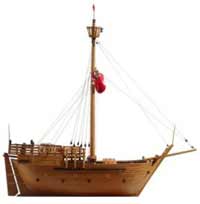 |
A broad beam trading
vessel used mainly in Europe between the 13th and 15th centuriesA
single-masted clinker-built vessel used until the 15th century. The Cog
originated in Northern Europe and spread throughout the Baltic and to the
Mediterranean. The first mention of a cog is from 948 AD in Muiden near
Amsterdam. The word Cog is derived from the word Kogge, a corruption of the
Dutch/Flemish word Kogel, meaning rounded or spherical. Even though the clinker
construction limited the ultimate size of a cog, Thomas Walsingham speaks of
great cogs in 1331 with three decks and over 500 crew and soldiers. A cog is
characterised by high sides, a relatively flat bottom, rounded bilge and a
single square sail. Also known as a Cogue. |
Collier
 |
A vessel designed
for the coal trade.
The only method open to owners of coal mines in the
Tyneside area of Northern England to get their coal to London, was by sea. A
large number of cheap to build and cheap to operate ships were required and the
type that met these criteria was the Collier Brig. The hull is bluff with no
ornamentation, with no beakhead or figurehead. We can assume that life on
board was hard, uncomfortable and dirty, dirtier even than was usual in those
no too hygienic days. Even the sails were blackened by coal dust in a few short
weeks. They generally arrived at the mouth of the Tyne and were loaded by keel
boats that had brought the coal from the pits up river. They were carrying
"Black Gold" and often subjected to attacks from Pirates, which forced them to
travel in convoy, sometimes with an escort. Soon the scene was set for the
North East of England to spawn what became the largest Collier fleet based on
one river - the Tyne collier brig was born and reigned supreme in the Pool of
London with all the resemblance of a black armada !. This Geordie fleet became
the biggest single group of coordinated shipping ever seen around these shores
and in consequence, was also a prime target of Press gangs. The masts,sails
and rigging would be as simple and consistent with strength and longevity.
Later brigs were longer and had more conventional bows, all in all they kept
London warm for over 250 years.
Length 77 ft.
Beam 24 ft.
Depth 12 ft.,
Tonnage 180 tons
Crew 10 - 25 men |
Corvette
 |
A corvette is a small, maneuverable, lightly
armed warship, smaller than a frigate. Almost all modern navies use ships
smaller than frigates for coastal duty, but not all of them use the term
corvette.
During the Age of Sail, corvettes were one of many types of smaller warships.
They were very closely related to sloops-of-war. The role of the corvette
consisted mostly of coastal patrol, fighting minor wars, supporting large
fleets, or participating in show-the-flag missions. The British Navy began using
small ships in the 1650s, which were referred to as sloops. The first reference
to a corvette was with the French Navy in the 1670s.
Most corvettes and sloops of the 17th century were around 40 to 60 feet (12 to
18 meters) in length and weighed 40 to 70 tons. They carried 4 to 8 smaller
guns. Corvettes slowly increased in size and capability, until 1800 when they
reached lengths over 100 feet (30 meters) and weight ranging from 400 to 600
tons (365 to 544 metric tons). One of the largest corvettes during the Age of
Sail was the American ship, USS Constellation, built in 1855. The ship was 176
feet (54 meters) long and carried 24 guns. It was so large that some naval
experts consider it a frigate. It has also been referred to as a sloop-of-war. |
Cutter
 |
The Cutter during the 18th and 19th centuries
was a small, single-masted vessel, fore-and-aft rigged, with two or more
headsails, a bowsprit, with a mast set further back than in a sloop.
Today the Cutter is a type of vessel employed my many government agencies for maritime law enforcement and customs
duties. |
Dhow
 |
Traditional Arab
sailing vessel with one or more lateen sails. It is primarily used along the
coasts of the Arabian Peninsula, India, and East Africa. A larger dhow may have
a crew of approximately thirty while smaller dhows have crews typically ranging
around twelve.Unfortunately, there is almost no pictorial evidence of early
dhows. Most of our knowledge of the dhow's early construction comes to us from
the records of Greek and early Roman historians.Despite their historical
attachment to Arab traders, dhows are essentially an Indian boat, with much of
the wood for their construction coming from the forests of India. |
Dinghy
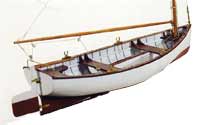 |
A small boat used
to travel from a ship to shore, carrying people or supplies.Although sometimes
equipped with a single sail, typically this type of vessel is generally only equipped with
oars. Also referred to as a dink or tender. |
Dory
 |
A dory is a small, shallow-draft boat of
approximately 5 to 7 m (15 to 22 ft) in length.Variant spellings are doree
and dorey (OED). The British Navy spells it 'dorey'. Lightweight and versatile,
these boats are used in the open sea for commercial fishing applications, as
well as in whitewater rafting on interior rivers. McKenzie River Dory versions
usually seat from two or three to four people including the oarsman.
The hull form is characterized by flat sides angled approx. 30 degrees from the
vertical, and a bottom that is transversely flat and markedly bowed
fore-and-aft. (This curvature is known as 'rocker'.) The stern is frequently a
raked surface (a narrow transom) that tapers sharply toward the bottom forming a
nearly double-ended boat. |
Drakkar
 |
The largest of the Viking ships, the Drakkar
were used for war and referred to as the "dragon-ships". These were a fairly
late invention (11th century) and were developed by kings such as Olaf
Tryggvasson. Although very effective, they were extremely expensive to build and
maintain.The largest of the dragonships, the Ormen Lange, had a length of
160 feet, a beam of 25 feet, as many as 72 oars, and it could hold a 300-man
crew. |
Drifter
 |
Normally used for
fishing, uses the tides and winds to cause it to be carried along |
Dromon

 |
As the Western Roman Empire fell to Germanic tribes and its own internal problems, the Roman Empire in the east, called the Byzantine Empire, flourished.
The Byzantine navy transported soldiers and supplies to help recover the Western Empire. The navy relied on fast galleys called dromons, or racers, to accompany and protect the supply ships.
Early dromons had a single bank of oarsmen, but Byzantine shipbuilders later incorporated a second level for oarsmen. |
Dutch Clipper
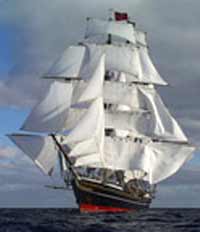 |
While the
majority of the clipper ships sailed under British and American flags, more then
a hundred clippers were built in the Netherlands. These ships were rather
medium-clippers than the larger extreme-clipper.In 1874 a Dutch government
investigation into the condition of the shipping industry, called the Enquête
of 1874, stated that in 1868 sixteen clipper ships with a total tonnage of
6000 tons, were registered. In 1873 there were eighteen ships (totalling
7878 tons). Although other sources mention a greater number of ships that can be
called medium-clipper. |
East Indiaman
 |
An armed
merchantman belonging to one of the East India companies (Dutch, British etc.)
Overall length: 171 feet bowsprit to spaniker boom
Hull length: 116 feet transom to figurehead
Hull breadth: 30 feet
Hull height: 20 feet keel to deck at midship
Paint Colors: Black with cream and yellow-goal trim; green, black, and red on
deck; copper below waterline
Main mast height: 120 feet to keel, 106 above deck line
Longest spar: Main yard, 52 feet 8 inches
Shortest spar: Mizzen royal yard, 14 feet
Length of rigging: 17 miles
Number of sails: 21
Sail area: 9,409 square feet (.216 acres); stunsails 8,712 square feet (.2
acres)
Ballast: 150 tons of lead
Construction method: Principle woods
used are Douglass fir and oak |
Fifie
 |
Design of sailing
boat developed on the east coast of Scotland, used by Scottish fishermen from
the 1850s until well into the 20th century. These boats were mainly used to fish
for herring using drift nets, and were known as herring drifters. Varied in
design, they can be categorised by their vertical stem and stern, their long
straight keel and wide beam.
These attributes made the Fifies very stable in the
water and allowed them to carry a very large set of sails. Their long keel made
them difficult to manoeuvre in small harbours. Fifies built after 1860 were all
decked and from 1870s onwards the bigger boats were built with carvel planking,
i.e. the planks were laid edge to edge instead of the overlapping clinker style
of previous boats. From about 1905 onwards sailing Fifies were gradually fitted
with engines and converted to motorised vessels. |
Fire Ship
 |
A fire ship is
a ship that is filled with explosives, deliberately set on fire and steered (or,
if possible, allowed to drift) into an enemy fleet in order to destroy ships or
create panic and make them break formation. |
Fishing Smack
 |
The Smack shown is the type that brought home the fish to Market for most of the 19th Century and even in small numbers up to the Second World War. The usual Smack was ketch rigged, but the boats varied from Port to Port. Some boats had a topsail on the Mizzen mast, while others might have a bowsprit carrying a jib. Large numbers of these boats could be seen operating in fleets out of places like Brixham, Grimsby and Lowestoft. The sails were usually red ochre in colour,
which made them a picturesque sight in large numbers.
Length 66 ft.
Beam 18 ft 6 ins
Depth 9 ft 6 ins |
Fluyt
 |
A three-masted,
square-rigged merchant ship of the 17th century, built by the Dutch to be
economical in operation, carrying the largest cargo and smallest crew possible.
It had a wide, box-like hull and a very narrow, high stern. Lightly armed, they
were not ideally suited for dealing with pirates and privateers or any other
armed conflict.
Also known as a Fluyt, Fleut, or Fluit |
Fly-Boat
 |
A 16th-19th
century flat-bottomed Dutch vessel with a very high and ornate stern with broad
buttocks, and with one or two masts either square-rigged on both or with a
spritsail on the mainmast.
They were of about 600 tons, and mainly used for
local coastal traffic. |
Fore & Aft Rig
 |
A
fore-and-aft rig is a sailing rig consisting mainly of sails that are set along
the line of the keel rather than perpendicular to it. Such sails are also
described as fore-and-aft rigged. |
Frigate
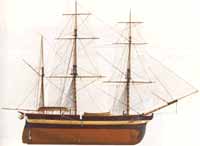 |
Three-masted
medium sized square-rigged sailing warship with two full decks, generally with
only the upper deck armed with between 28 to 60 guns, used in the 18th and 19th
centuries, mainly for escort duties and reconnaissance. The American
'super-frigates' of 1812 deviated somewhat from this single gun-deck rule.
Length 212 ft.
Beam 48 ft.
Depth 19 1/4 ft.
Tonnage 1,605 tons
Crew (Wartime) 815 |
Full Rigged Ship
 |
A full
rigged ship or fully rigged ship is a square rigged sailing vessel with three or
more masts, all of them square rigged. Sometimes such a vessel will merely be
called a ship, particularly in 18th - early 19th Century and earlier usage, to
distinguish it from other vessels such as schooners, Barque, Barquentines,
brigs etc. |
Fuste
 |
A small ship with both sail and oars. It was fast, long and had a low profile,
it was possibly developed
from the Tartan. The ship was fast and capable of using both sail and oars.
This vessel quickly became a favorite of the Barbary and Salé pirates. |
Gaff Rig
 |
Gaff rig is a
sailing rig (configuration of sails) in which a sail is a four-cornered
fore-and-aft rigged sail controlled at its peak, and usually entire head, by a
spar (pole) called the gaff. The gaff enables a fore and aft sail to be four
sided, rather than triangular, up to doubling the sail area that can be carried
by the same mast and boom. |
Galera
 |
17th century
galley, LOA: 55 m ; Width: 8.70 m ; Displacement: 190 tons |
Galere
 |
17th century
galley.LOA: 55 mWidth: 8.70 mDisplacement: 190 tons |
Galiote
 |
Galliot
(Galiote): In the Mediterranean a Galliot referred to a small single
masted,single sailed galley type vessel with 20 oars. Northern Europe (and
particularly Dutchusage) refers to a small 1 or 2 masted ship with main and
mizzen mast lateen rigged and asquare topsail and possibly a top gallant on the
main. The hull was characterized by abluff (steeply sloped) rounded bow, a
characteristic of many northern (and especiallyDutch) ships |
Galleass
 |
A compromise
between the oared galley and the galleon, in which oars were retained to provide
free movement irrespective of the direction of the wind although masts and sails
were also carried. In order to accommodate the masts and rigging, galleasses had
to be built with a greater beam and deeper draught than the galley. They were
lateen rigged on two or three masts, but suffered from the inevitable defects of
compromise, being unable to carry the more effective square rig of the sailing
ship because of the modified galley hull form and also, for the same reason,
being unable to retain the speed and maneuverability of the true galley.
Six galleasses were included in the Spanish fleet for the Armada campaign
but were unable to accomplish anything in the stormier waters of the English
Channel and North Sea. |
Galleon
 |
A large, three or
four masted, square-rigged, multi-decked sailing ship used primarily by the
nations of Europe (particularly by the Spanish and Portuguese) from the 16th to
18th centuries. Whether used for war or commerce, Galleons were generally
lightly armed, even for their time. A galleon was a large, multi-decked sailing
ship used primarily by the nations of Europe from the 16th to 18th centuries.
Whether used for war or commerce, they were generally armed with cannons.
Galleons were an evolution of the caravel and carrack (or Nao), for the new
great ocean going voyages. A lowering of the forecastle and elongation of the
hull gave an unprecedented level of stability in the water, and reduced wind
resistance at the front, leading to a faster, more maneuverable vessel. The
galleon differed from the older types primarily by being longer, lower and
narrower, with a square tuck stern instead of a round tuck, and by having a
snout or head projecting forward from the bows below the level of the
forecastle.
In Portugal at least, carracks were usually very large ships for
their time (often over 1000 tons), while galleons were mostly under 500 tons,
although the Manila galleons were to reach up to 2000 tons. Carracks tended to
be lightly armed and used for transporting booty from the Far East, while
galleons were purpose-built warships, and were stronger, more heavily armed, and
also cheaper to build (5 galleons could cost around the same as 3 carracks) and
were therefore a much better investment for use as warships. There are
nationalistic disputes about the origin of the galleon, which are complicated by
its evolutionary development, but each Atlantic sea-power developed types suited
to their needs, while constantly learning from their rivals. |
Galley
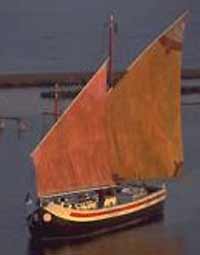 |
A sea going vessel
propelled mainly by oars used in ancient times. Also the term used for a kitchen
on a sea vessel. The oared fighting ship of the Mediterranean dating from about
3000 B.C. and lasting into the 18th century A.D. Originally propelled by oars
arranged on a single level, galleys were developed with oars arranged in banks,
or different levels. The weapon of the galley was the ram, a pointed spur fixed
to the bow of the galley on or just below the waterline. In the 16th and 17th
centuries guns were mounted on a platform in the bows of galleys, but they could
not be trained and had to fire directly ahead. A low, long vessel propelled
either by oars or sail. These are the vessels associated with the ancient times
of Greece and Rome. Still in use between 1500 and 1600 |
Gallivat
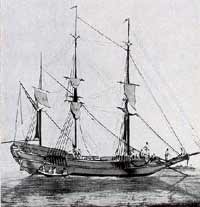 |
18th century
ship propelled by 40-80 oarsmen and 1-2 sails, commonly used by the Angrian pirates in
the Indian Ocean. |
Goélette
 |
French version of a the common
Schooner, a two-masted fore and aft rigged vessel |
Gunter Rig
 |
The gunter is
defined as a wire that leads from one point near the end of a gaff to a point
near the other end. A block travels along this wire, and a halyard is attached
to this block.This allows the gaff to be raised to the vertical by a single
halyard, though another halyard is required at the gaff jaws to control height. |
Hermaphrodite Brig
 |
The 19th Century brig, with all its variants, was a very popular ship in the shipping world. It was smaller than the ship
or barque and so was cheaper to operate. It could be used in all the smaller
coastal ports that the coasts of those days seem to have every few miles. The
brig had a fine lined hull and brigs like this could be seen in any port in the
world. The Royal Navy retained some brigs right up to the beginnings of the 20th
century and they remained as training ships well into the century
Length 125 ft. 8 ins
Beam 26 ft.
Depth 12 ft. 9 ins
Tonnage 234 tons |
Herring Buss
 |
From the Tudor period onwards, the fishing
fleets of Northern Europe increased until they were very large. The vessel
shown is from a Dutch engraving. When fishing and bringing in the catch, the
centre mainmast and the foremast seem to have been lowered so that the standing
rigging would be cleared out of the way and almost the entire length of the ship
could be used to work the nets. Many of the busses were flush decked, with only
limited accommodation below deck for the crew.
Length 65 ft.
Beam 16 ft.
Depth 8 ft. |
Howker
 |
The Hooker or "Howker "as it was often called
in England was also called by the French a "Houcre" or "Hourque "and by the
Dutch "Hoecker", was another type of small merchant vessel used in the coastal
waters of Northern Europe. The hooker was a vessel that varied according to
locality or time. Some hookers had pole masts, while others had the more usual
separate mainmast and topmast, with tops, shrouds and the rest. All of the
hookers had bluff rounded bows and sterns, with a high rudder and tiller fitted
over the bulwarks.
Length 87 ft.
Beam 22 ft.
Depth 9 ft.
Tonnage 120 tons |
Hulk
 |
Originally a large
ship used either as a transport or for carrying merchandise, particularly in the
Mediterranean where hulks ranged up to about 400 tons. It was contemporary with
the carrack and occasionally described as such. In general, any large and
unwieldy ship of simple construction with a rounded bow and stern was described
as a hulk.
Term also refers to an abandoned decaying vessel |
Humber Keel
 |
The Humber Keel was a bit of a mixture. The
sails were almost a relic of the Middle ages, while the hull was double ended,
flat floored rather boxy type of affair, very good for carrying the maximum
amount of cargo on the Yorkshire rivers and canals. A small cabin was located
in the extreme stern. Lee boards were fitted and the mast could be lowered so
that bridges could be negotiated. A heavy rail was carried round the stern and
on this were carried a lifebelt or two, plus navigation lights.
Length 61 ft. ( 18.3 m)
Beam 15 ft 6 ins
Depth 7 ft
Tonnage 90 - 100 tons
Crew 1 man and a boy, plus dog |
Ice Boat
 |
A small boat
typically used for transportation across the
Northumberland Strait prior to 1918 during the Winter Months. Typically, they
were 5 metres long, and 1.2 metres wide, and were covered with tin to protect
the vessel from the ice. Often they had metal runners on the sides of the
keel. They were outfitted with sails and oars, and could be rowed or paddle
across the Strait. When the ice grew too thick, the crew and male passengers in
exchange for a lower rate, would pull the boat across the ice. The vessel was
equipped with leather harnesses to attach the crew to the vessel while pulling,
also protecting them from drowning when the ice gave away. |
Ironclad
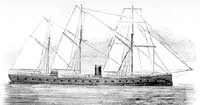 |
Ironclad warships, frequently shortened to just ironclads, were wooden ships or ships of composite construction (wooden planking on iron frames) sheathed with thick iron plates for protection against gunfire. The first uses of iron for naval protection occurred in the Far East in the 16th century, but the heyday of the ironclad came in the mid-19th century, when ironclads supplanted wooden ships, and then were themselves replaced by ships made of steel. |
Junk
 |
Chinese sailing
vessel with varying numbers of masts and whose sails are comprised of bamboo
sail battens with a long overhanging counter. The English name comes from Malay
dgong or jong, but is also known by the French word "Jonque". Junks were originally developed during the Han Dynasty (220
BCE-200 CE) and further evolved to represent one of the most successful ship
types in history, and are still in use today. |
Ketch
 |
A two-masted
sailing vessel similar in appearance to a yawl but with the mizzenmast stepped
forward of the rudder post. The Ketch is usually fore-and-aft rigged is commonly
rigged to have square sails, and has a tonnage ranging from 100 to 250 tons.
Often tasked to the role of a bombard vessel. |
Knorr
 |
The most common
type of longship, the knorr was the workhorse of Viking cargo ships, the
mainstay of the Icelandic traders. The best-known example of a knorr is the
Gokstad ship.
A knorr could carry up to 20 tons of cargo, or a volume equal to 3
tons of vathmal (finely woven homespun wool cloth), or 30 tons of flour-milled
grain, or 5 tons of whole-grain barley. A knorr relied mostly upon its sails,
having only 4 to 7 pairs of oars and a crew of 15 to 20 men or less. Unlike the
dragonships, the knorr couldn't have oarsmen amidships, for the cargo would be
in the way.Consequently the knorr used oars only for specialized tasks, such as
docking, or keeping the bow into the wind during a storm. All longships used a
single square-rigged sail made of vathmal secured with ropes made of seal- or
walrus-skin. While the dragon-ship could unstep its mast (take the mast down for
safety or storage), the knorr's mast was fixed and could not be removed. This
posed some danger in storm conditions, and the Icelandic annals record the loss
of often several cargo ships each year.
These same annals indicate that the
lifetime of the knorr was 20 to 30 years when properly cared for (and when Ran
and Aegir - the deities of sea-storms and drowned sailors - didn't claim a ship
as their own). When referring to multiple Knorr vessels, the correct term is "Knerrir" |
Launch
 |
A small boat used to travel from a boat to
shore, carrying people or supplies. Typically this type of vessel is only
equipped with oars but may were modified as shown on the left with basic sails. |
Liberty ship
 |
An American
merchant ship of the late Second World War period, designed for rapid building
in large numbers, resulting in the earliest class of welded ships.
Although these ships were not sail powered vessels (and therefore really not
supposed to be on this list) these ships truly embodied the true spirit of the
sail ship era and have been included out of respect for that |
Liburnian


 |
With two oar banks. Used from around 300BC,
initially as a pirate vessel. Later adopted by the Romans who used it as a
standard warship. As a pirate, the vessel was usually painted blue-grey as a
rudimentary form of camouflage.
The liburnian ('liburnidas') was a type of lembos (type of warship); it was a
single-banked galley. The Romans borrowed the design from foreign cultures.
Originally the liburnian was used for raiding by the 'Liburni', a tribe of
seafarers and pirates who invented it. They used it for raiding on the coast of
Illyria, Yugoslavia. They also used it in piracy in the Adriatic and near
various islands. It was possibly copied from craft used by the Britons, who
themselves had copied a Pictish type of craft from Scotland. The Romans adopted
the design in the first century BC. Sometimes, however, for better oar power,
the Romans built the liburnian as a bireme. In later Roman times, the liburnian
was a different craft altogether, but the Romans retained the same name as the
new craft was also intended for war purposes.
The liburnian had several uses: - To sail ahead of the Roman fleet; for
reconnaissance, along coasts etc.; and to guard the Roman Empire. - To
communicate between important ships in the fleet. - To take up position, before
battle, between larger ships. - To form detachments of liburnians; which could
be used for pursuit, and for offensive purposes, coastal patrol, and anti-piracy
defence. - To be part of provincial squadrons (eg. a squadron of liburnians,
headed by a three as the flagship) on expeditions etc.; especially to Egypt, and
along the Danube. |
Longship
 |
Oar powered
Viking ship with one square sail constructed for speed |
Lorcha
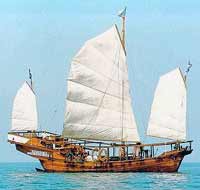 |
Sailing vessel with
a western style hull and Chinese style rigging |
Lugger
 |
A sailing vessel
with a lugsail rig, normally two-masted except when they were used for smuggling
or as privateers, when a mizen was stepped right aft. There is some disagreement
as to when the lugger came into use, however, a chart published as early as 1586
shows a two-masted vessel with what appears to be a lugsail forward equipped
with vangs and a bonnet, a bowsprit, a spritsail, and a lateen mizen sheeted to
an outrigger. Lugsails are also mentioned by many writers of the 16th and 17th
centuries. |
Man of war
 |
Term refers to
ships armed with cannon and propelled primarily by sails as opposed to a galley
– propelled primarily by oars.
Developed in the Mediterranean in the 15th
century from earlier roundships with the addition of a second mast to form the
carrack. The 16th century saw the carrack evolve into the galleon and then the
ship of the line.
A first-rate man of war, such as the HMS Victory was armed
with 100 or more guns (as many as 120). The 90-gun HMS Coronation was a
second-rate man of war. A seventy-four, a common ship carrying 74 guns, was a
third-rate man of war. A sixth-rate man of war carried only 20 guns. First and
second-rate men of war had three gun decks. It took over 2,000 oak and elm trees
to build a second-rate man of war.
 |
Mersey Flat
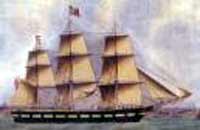 |
Two masted,
doubled-ended barge with rounded bilges, carvel build and fully decked. Common
from the 1730's to 1890s. These vessels originated on the River Mersey but where
also used on Rivers Irwell and Weaver. |
Nao
 |
three or four masted
sailing ship developed in the Mediterranean in the 15th century. It had a high
rounded stern with an aft castle and a forecastle and bowsprit at the stem. It
was square-rigged on the foremast and mainmast and lateen-rigged on the
mizzenmast. |
Nave
 |
Lateen-rigged
sailing ships, also known as Navi.
Strong and
swift Spanish ship (probably a galley) which in the old fleets played a part
equivalent to that of the Fragatas. |
Norfolk Wherry
 |
The
Norfolk wherry is a black-sailed trader, type of boat on The Broads in Norfolk.
It is double-ended with the mast steeped well forward, painted black with a
single gaff sail. Mostly clinker-built, it would carry around 25 tons of goods.
Wherries were able to reach larger boats just off coast and take their cargoes
off to be transported inland through the broads and the rivers. |
Packet
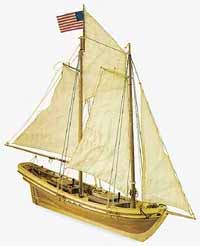 |
The packet ship
was the workhorse of the passenger service. It has been said that the packet was
born of necessity, because she had to withstand the violence of brutal seas and
the stress imposed by hard case masters who strove to keep a schedule under all
conditions. Her crew were often called packet rats because of their dubious
backgrounds. Packet ships were sturdy, full-bodied, and somewhat tubby in
appearance. In the era of sail, the typical packet measured about 1,000 tons, a
rough indicator of cargo-carrying capacity. In length, these ships averaged
about 170 feet, and in breadth, about 35 feet. The largest packet sailing vessel
was the Monarch of the Sea, measuring 1,979 tons and 223 feet long - not quite
as long as a Boeing 747 airplane. In contrast with modern vessels, even this
ship was relatively small. |
Paddle steamer
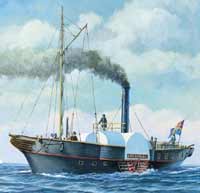 |
Steam-propelled, paddle-driven vessel, a name commonly applied to nineteenth
century excursion steamers. |
Pantserschip
 |
A Dutch
ironclad. By the end of the nineteenth century, the name was applied to a heavy
gunboat designed for colonial service. |
Patache
 |
A swift dispatch
row-sailing vessel used for courier and reconnaissance service, but sometimes
for coastal patrols. |
Penteconter
 |
An ancient
warship propelled by 50 oars, 25 on each side. |
Pinnace
 |
Small two masted
vessel often used for carrying messages between the larger vessel of the fleet |
Pinque
 |
A small square rigged
vessel. A small square-rigged ship with a narrow and overhanging stern, often used for
the carriage of masts. In the 15th and 16th centuries the name was loosely
applied to all small ships with narrow sterns, a fairly common design.Also
known as a pink. |
Polacre
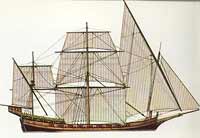 |
Type of
seventeenth-century sailing vessel, similar to the xebec. Frequently seen in the
Mediterranean. It sports three single-pole masts, often with a lateen hoisted on
the foremast (which is slanted forward to accommodate the large lateen yard) and
a gaff or lateen on the mizzen mast. The mainmast is square rigged, after the
European style. Also known as a polacca |
Pontoon
 |
Generic term for a type of boat with
a flat deck attached to airtight flotation tubes or logs. This very basic
boat design has existed in one form or another throughout all of human history.
Uses for this class of vessel are typically be limited only to local river,
canal, or lake uses. |
Pram
 |
A small dinghy,
originally of a clinker construction and called in English, as in Danish, a
praam. The Danish orthography has changed so that it would now be a pråm in its
original language.
It has a transom at both ends, the forward one usually small
and steeply raked in the traditional design. |
Proa
 |
A Proa is a
multihull vessel consisting of two (usually) unequal parallel hulls,
superficially similar to an outrigger canoe. Found in many configurations and
forms, it was developed as a sailing vessel in Micronesia (Pacific Ocean), and
forms of it may be found as far as Madagascar and Sri Lanka. The word proa comes
from perahu, the word for boat in Malay, which is similar to the Micronesian
language group. |
Quadrireme
 |
The Trireme (Greek trieres) was a "state of
the art" wooden hulled fighting ship designed to be able to cover long distances
quickly under oar and sail, and in battle to ram enemy ships with devastating
effect.Money from the new vein of silver in Laurion enabled Athens to buy
timber from Italy to increase her fleet from 40 in 489 BC to 200 in 480. The
polis paid for the ship and its crew: equipment and repairs were paid for by a
rich citizen as one of the liturgies (trierarchia - an Athenian notion which
shamed the richest citizens into reinvesting their wealth on the cities in which
they lived without the need for taxation).Configured with square rigged
sails on between 1 and 3 short masts, the craft was also rigged with three tiers
of oars for rowers to provide "human-powered" propulsion should the vessel
encounter calm winds or for better control during combat, and capable of
reaching speeds up to an astonishing 10 knots.One of the many noteworthy
elements of this class of vessel was the bronze armored ram positioned on the
bow of the ship. This was designed to be driven into an enemy ship with maximum
force in order to cause a breach in the other ship's hull below the waterline
and thus sink it. Although a very small number of men were required to crew the
ship when relying on the sails, the ship could be equipped with as many as 65
sailors during times of combat, as well as additional archers or soldiers on the
main deck for boarding enemy vessels once they have been rammed.A full-scale
replica of a trireme was launched in 1987, painstakingly reconstructed, using
all available ancient evidence (especially the Lenormant relief). |
quinquereme
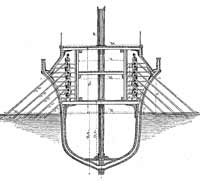 |
An ancient
warship propelled by three banks of oars. On the upper row three rowers hold one
oar, on the middle row - two rowers, and on the lower row - one man to an oar.
A fast multiple-masted sailing ship. |
Saettia
 |
Small lateen
rigged Venetian sailing vessel |
Sampan
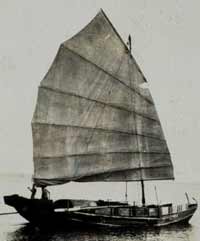 |
A sampan is a
Asian skiff constructed of wood, ranging from twelve to fifteen feet long and
generally propelled by two oars. Some sampans include a small shelter on board,
and may be used as a permanent habitation on inland waters. |
Schooner
 |
A vessel with
two or more masts, with fore and aft sails on both masts, normally less than 150
tons, but some of the triple masted schooners built on Prince Edward Island in
the 1880's exceeded 700 tons. |
Schooner
(Fore andAft)
 |
The Fore and Aft Schooner is a rig that is
fairly modern, being popular still for some trades in the Pacific where sailing
ships are still employed in small numbers. The chief advantage of this rig was
that it was very economical with man power. It became very popular, and some
very large schooners were built, the largest being the " Thomas W Lawson "
which boasted 7 masts, all the same height, with gear and sails that were more
or less interchangeable. A crew of 16 was able to handle this ship if 5,200
tons.
Length 146 ft
Beam 35 ft
Depth 12 ft 8 ins
Tonnage 475 tons |
Shallop
 |
large, heavily
built, sixteenth century boat with one mast carrying fore and aft sails,
normally of less than 25 tons.
Known to be a fairly frail open boat. |
Ship of the line
 |
sailing
warship of first, second or third rate. That is, with 64 or more guns. Before
the late eighteenth century, fourth rates (50-60 guns) also served in the line
of battle. |
Sloop
 |
Single masted
vessel, fore and aft rigged with at least one jib, of less than 25 tons. Used in
modern times primarily for pleasure boating and racing |
Smack
 |
The Smack was an
English sailing vessel that was used to bring the fish to Market for most of the
19th Century and even in small numbers up to the Second World War. The Smack was
ketch rigged, but the boats varied from Port to Port. Some boats had a topsail
on the Mizzen mast, while others might have a bowsprit carrying a jib. Large
numbers of these boats could be seen operating in fleets out of places like
Brixham, Grimsby and Lowestoft. The sails were generally red ochre in colour,
which made them a picturesque sight in large numbers. |
Snow
 |
Two-masted sailing
vessel of the era, the snow, carried square sails on both masts, with a trysail
on a jacknast known as a snowmast --which was a spar set on the deck about a
foot behind the mainmast and attached at the top to the mainmast. Also: A Snow
Rigged Vessel or Snow Rigged Brig had similar rigging. |
South Coast Lugger
 |
There was a time when all the best or worst
melodramatic villains, when plotting their villainy, used to twirl their ample
mustachios and say " Once aboard the lugger and the girl is mine "- or words to
that effect. Whether the girls were afraid of the villians or the discomfort
aboard the lugger and never been revealed. Luggers were popular craft, as they
were built to live in any weather and they all had a reputation of being fast,
whether being pursued by furious Fathers or contraband seeking Customs officers. Despite all of the foregoing, luggers were built for fishing duties and as
such they were used round most of the coasts of Britain and France. The luggers
differed considerably according to their local and were from a few tons to 200
tons. Early sailing lifeboats were rigged with Lug Sails and so were technically
luggers. A south coast lugger is shown in the drawing.
Length 46 ft
Beam 12 ft
Depth 4 ft |
Tall Ships
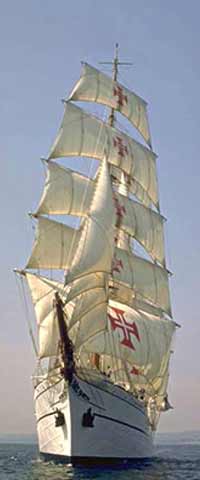 |
large
traditionally rigged sailing vessel. Popular modern tall ship rigs include
topsail schooners, brigantines, brigs and barques. Traditional rigged vessels
differ from modern sailing vessels with gaff rigs, topmasts and topsails. Due to
the additional crew and rigging required to carry topmasts and gaff rigs and the
ability to construct taller, hollow masts of aluminum and steel, separate
topmasts are generally cost prohibitive on modern designs. |
Tartane
 |
French commercial
sailing vessel with a small square yard sail and raffee topsails above the
lateen main sail. |
Tern Schooner
 |
American
term for 3 masted schooner rigged fore and aft. |
Thames Sailing Barge
 |
The barge in the drawing comes from an
engraving by E.W. Cook and this barge differs from the traditional barge in
several ways, so that it represents a barge of 1827 - 1830. Later barges
tended to have simpler sail plans, needing either fewer crew or making fewer
demands on the existing crew. The configuration shown was called a " swimhead "
or swimmie. All types of Thames Barges were equipped with lee-boards.
Length 77 ft
Beam 16 ft
Depth 6 ft
Crew 2
Tonnage 140 tons |
Trawler
 |
A vessel used to
trawl for fish |
Trimaran
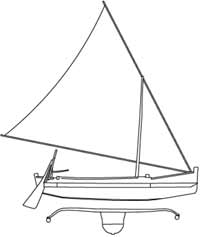 |
multihull boat
consisting of a main hull and two smaller outrigger hulls (amas), attached to
the main hull with lateral struts (akas).
The design and names for the trimaran
components are derived from the original proa constructed by native Pacific
Islanders. |
Trireme
 |
The early type had three rows of oars on each side, manned with one man per oar. They originated with the Phoenicians and are best known from the fleets of Ancient Greece. The early trireme was a development of the pentekonter, an ancient warship with a single row of 25 oars on each side. The trireme's staggered seating permitted three benches per vertical section with an oarsmen on each. The outrigger above the gunwale, projecting laterally beyond it, kept the third row of oars on deck out of the way of the first two under deck. Early triremes were the dominant warship in the Mediterranean from the 7th to the 4th century BC.The heavily armored Greek/Phoenician trireme was the mainstay of most navies during the times of quinquiremes/penteres. Like these, all rowers were now protected under deck and battle was mainly fought by marines. A different system of classification was also used, referring to the men per vertical section, so that they did not necessarily have three rows of oars any more.Light Roman triremes supplanted the liburnians in the late Roman navy. They were like the early triremes a light type of warship, but with 150 rowers under deck instead of 170, with little armor, but significantly more marines and less structural support for ramming. Later it developed into the heavier dromon.
|
Turtle Ship

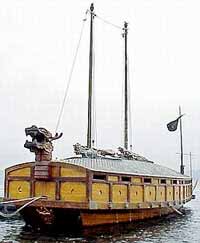
 |
The Turtle Ship (also known as Geobukseon or Kobukson by its Korean name) was a large warship belonging to Panokseon class in Korea under the Joseon Dynasty between the 15th century and 18th century. While many believe it to be an early ironclad ship, the actual design of the early ships, and whether they used iron armor, is unclear. The Korean Admiral Yi Sun-sin is credited for resurrecting and improving the Turtle Ship from an older design, resulting in the craft known today.The turtle ship is famous for its large part in winning sea battles against Japanese ships during Hideyoshi's Invasions of Korea.
The first references to Turtle Ships come from 1413 and 1415 records in the Annals of the Joseon Dynasty. These Turtle Ships were mentioned as spear-ships or ramming ships and were mainly used to thwart Jurchen and Japanese pirates. Later though, these early Turtle Ships soon fell out of use because of a long period of peace, during which Korea flourished.Turtle Ships equipped with at least five different types of cannons were in use during the Imjin War between Korea and Japan, and later on when Admiral Yi recreated them. There were at least 40 commissioned Turtle Ships in 1782.
|
Wherry (Typical)
 |
boat used for
carrying cargo on rivers and canals in England. Wherries evolved into a
gentleman's rowing boat. They are generally long and narrow, with a straight
stem, a wineglass stern and usually carvel planked. (smooth sides) The boat
usually has two seats, one for the rower, and one in the stern sheets for the
passenger, although longer ones can have a third seat forward. Modern longer
craft are often set up to be rowed with a sliding seat as either a single or a
double. |
Wherry (Norfolk)
 |
The Norfolk Wherry is another type of coastal
and inland cargo carrier. The Wherry was evolved for the Norfolk Broads, the
lakes and rivers that criss cross Norfolk, and the outlet to the sea at
Yarmouth. The large Gaff sail could be hoisted by one man using the windlass
before the mast. Most of the hull was taken up by the hold, which could hold
upto 30 tons of cargo. The mast could be lowered to negotiate bridges. In
adverse or quiet weather the wherry had to be poled along which required very
strong men indeed. The Broads village of Potter Heigham used to be a centre for
wherries, but there are very few left. on these boats, no lee boards were
fitted.
Length 60 ft
Beam 12 ft
Depth 3 ft
Crew 2 |
Windjammer
 |
type of
sailing ship with a large iron hull, used for cargo in the nineteenth century.
They were the grandest of cargo sailing ships, with between three and five large
masts and square sails, giving them a characteristic profile. They frequently
displaced several thousand tons, and were cheaper than their wooden hulled
counterparts for three main reasons: iron was stronger, and thus could enable
larger ship sizes and considerable economies of scale, iron hulls took up less
space and allowed for more cargo to be carried, and iron hulls were cheaper to
maintain than an equivalent wooden hull. |
Xebec
 |
A xebec is a type of ship that operated mainly in the Mediterranean Sea from about 1650 to 1820. It was used primarily by Barbary (North African) Corsairs, who traded in their galleys for sail power and broadside capacity. These ships had low, long hulls similar to a galley, with considerable overhang at the bow and stern.They were equipped with three lateen-rigged masts, the fore and mizzen having considerable rake to the bow and stern respectively. |
Yacht
 |
Originally defined
as a light, fast sailing vessel that is 26 feet or more in length and generally
used to convey important persons. In later times, the definition came to mean
any vessel, other than a dinghy, propelled by sail, power or both and used for
pleasure cruising and/or competitive sail racing.
The term originated with the
Dutch. |
Yawl
 |
From the Dutch
word Jol, this type of ship is a two-masted sailing craft similar to a sloop
or cutter but with an additional mizzen mast well aft of the main mast, often
right on the transom. A small mizzen sail is hoisted on the mizzen mast. The
yawl is often confused with the ketch, which also has two masts with the main
mast foremost.The official difference is that a ketch has the mizzen mast
forward of the rudder post whereas the mizzen on a yawl is aft of the rudder
post. In practice, on a ketch the principal purpose of the mizzen mast is to
help propel the vessel, while on a yawl it is mainly used for the purposes of
trim and balance. In consequence the mizzen sail of a yawl tends to be smaller,
and the mainsail larger, when compared to a ketch of similar size. The mainsail
of a yawl will be similar in size to that of a similarly sized and proportioned
sloop.
Length 29 ft
Beam 8 ft
Draught 3 ft 6 ins |
Yorkshire Billy Boy
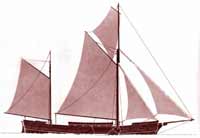 |
The Yorkshire Billyboy was a modification and
development of the Humber keel. On the whole, the hull was somewhat larger and
especially deeper. with bulwarks to give greater freeboard. The hull was well
rounded at the stern, with a cabin and small hatchway. Lee boards were usually
fitted.
Length 75 ft
Beam 18 ft
Depth 8 ft
Crew 1 man and his family |
Click on the Piece of Eight to return to the Main Page
 |
|
 |
|
|
|

